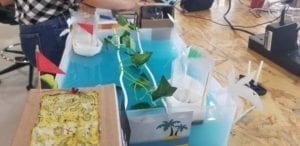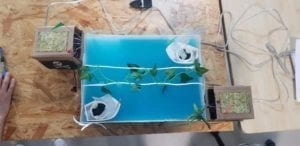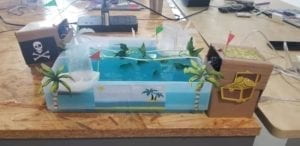At the beginning of the semester, I had a rather vague understanding of the term “interaction”. My initial assumptions pinned the definition as something that you must use your senses to invoke a reciprocated action. Before taking Interaction Lab, previous examples of interaction came from ideas like video games, robots, and human conversations. Although my current definition of interaction is not entirely off from my preconceived understanding, I believe interaction is as simple as a metaphorical conversation. Having read Crawford’s definition from “The Art of Interactive Design”, my definition of interaction stems from his idea that you must have two or more actors that participate in a dialogue through thinking, speaking, and listening. Looking at other interactive projects, such as Baba Tetsuaki’s Frectric Drums— a device where four users are required to hold each side in order to create a circuit that allows for them to create drum sounds with their palms– I was inspired to develop something unique in its interaction in a way that allowed people to think collaboratively in order to get a device to respond. We decided it would be an interesting thought experiment if we created a game in which disguised itself as a competition where users would have to decide whether to sacrifice their opponents in order to win when in reality the objective could be more easily achieved when working together.
The concept of Pirate Chase started with the idea that we would create a competitive game in which users initially worked against one another but ultimately would realize the benefit of collaboration. Having completed the recitation in which we were required to build a game where users competed against each other to press a button the fastest, I was inspired to create a similar carnival-style game. Thinking back on my very first understanding of interaction, I thought about what senses would be interesting to utilize in my project. The idea of making boats that required you to blow on them to move stemmed from this idea, as I realized it’s a lot more challenging and fun to interact with something you can’t physically touch. This led us to the idea that two users would stand opposite one another and compete to get a boat across a body of water, in which a sensor would then illuminate an LED light signaling their victory. The boats we 3D printed and attached plastic-bag sails fastened by toothpicks. The boats were then placed inside a large plastic container filled with colored water, where we then attached wires to divide the space into two separate lanes for each boat. Lastly, we placed infrared sensors on each end of the plastic container that when in close proximity, a red LED light would illuminate.
Throughout the development process, we faced many hurdles. During user-testing, the first major drawback to our initial draft of Pirate Chase came from our boats. The first model of boats we made were rather small and, therefore, often sank in the water. After seeing how hard users would blow onto the boats when faced with a competitive challenge, we realized that our boats needed the structural integrity to consistently float under strong force. At the last minute, we found a new model of boats that adequately satisfied our buoyancy requirements and the problem was fixed. Another problem we ran into was that users weren’t really sure what the objective of the game was without explanation. However, by adding in the wires to create lanes, this quickly fixed the problem as it clearly directed users where to blow their boats. In addition, by placing the LEDs more in a more visible location to both users, the outcome of winning by reaching the sensor became more apparent. Lastly, we decided to add a third electronic component that set off a buzzer sound as we thought it was a clearer way of letting users know when the game starts and when to begin blowing.
Once again, the goal of our project was to allow for two users to compete against one another with an interactive game, which in turn would allow them to realize the benefit of collaboration. I believe that we tried hard to make our project as fit to our definition of interaction as possible, and to some extent, we succeeded. The idea of blowing on the boats in order to get them to access the sensor is perhaps most in-line with our definition of interaction. However, looking back on our original concept I believe there was an opportunity to make the game more interactive and even more fit towards our goal for the project. When watching users interact with Pirate Chase, I think it wasn’t very obvious that they could blow against their opponent’s boat and therefore the thought experiment was less effective. I believe that a more suitable design for this project would be a large circular container where a singular sensor is placed in the middle, like an island. With this new design, more boats could be added and competitiveness would not only amplify, but the effort to get your boat to the island would become more of a challenge. I think in this case, users would be more likely to interact with other users’ boats, whether it be for their own advantage or as a collaboration. I’ve realized from this project that it’s important not to stubbornly hold onto preconceived notions or assumptions when creating something, rather it’s best to listen and adapt to aspects that aren’t currently working for the benefit of making something more interactive.



Bibliography:
http://s3-ap-southeast-1.amazonaws.com/ima-wp/wp-content/uploads/sites/3/2017/08/05164121/The-Art-of-Interactive-Design-brief.pdf
https://drive.google.com/file/d/1q7adHt5BCv0QQMwBVBaGEfG6pGGfQX9b/view